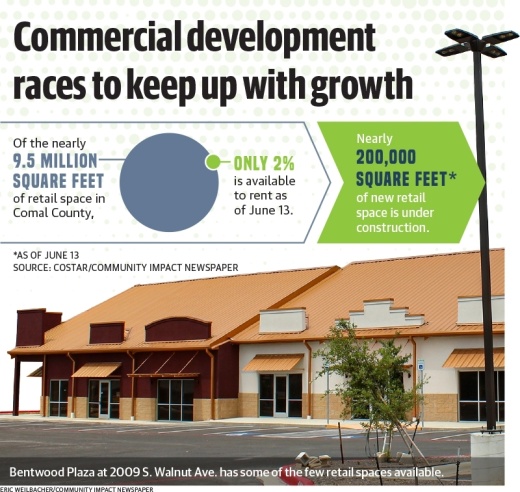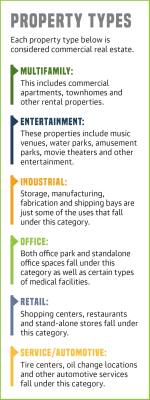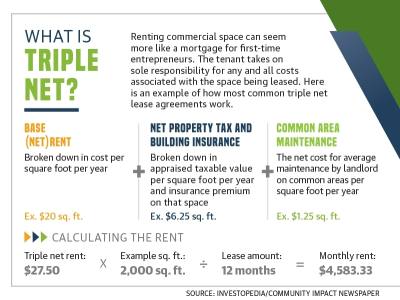At the same time, a very low rate of vacancy in some areas of commercial real estate, such as office and retail, is putting pressure on developers to build more around New Braunfels to bring increased options for businesses.
“We’ve seen nearly 100% absorption of our office market,” said Jonathan Packer, president of the Greater New Braunfels Chamber of Commerce. “We have opportunities emerging where there’s going to be some evolution of all of our retail areas both new and existing in the city to bring jobs and people clustered together and to attract the right type of job. We need to have the spaces that allow us to compete for those opportunities.”
Data produced for the GNBCC from CoStar Group, an organization that researches and analyzes the commercial real estate industry, shows that nearly 200,000 square feet of new retail construction is under construction in 2022.
Of the currently nearly 9.5 million square feet of total retail space on the market, 2.1% of it is available. Inventory of office space has also expanded more than 11% over the past three years while remaining virtually completely occupied, according to the data.
Even commercial properties that lagged and sat vacant for years are now filling up, said Mike Ybarra, principal with Legacy Commercial Real Estate in New Braunfels.
“When you start getting to infill sites, the sites that are incredibly challenged, ... you’re seeing them go under contract at very reasonable prices,” Ybarra said. “We’re virtually out of office space, and we’re virtually out of retail space at this juncture. So there is a need for developers to provide more of that product type. We have so many tenant requests for space for both medical office and retail. And yet we just don’t have the product to be able to really seriously discuss with for the most part.”
Navigating a hot market
While there is not one singular factor or dataset in determining why a commercial real estate market might be so competitive locally, there are a few things to consider to understand why it is happening, Packer said.
One area to look at is not just New Braunfels’ population growth, but what age ranges are growing the most.
Within the San Antonio-Austin corridor, New Braunfels is growing five times faster than the rest of the corridor in the population under 18 years old, three times faster in those 25-44 years old and three times faster for those 45-65 years old, according to Packer.
“In a five-year period, the percentage of the population with a bachelor’s degree or higher grew by 11.5%. In the under 18 bracket we’re growing at basically an elementary school a year,” Packer said. “People in their prime working years with credentials, skills, professions that take education are moving here with children, and so when we really dug into the data, that directly affects our definition of what adds value economically.”
Packer said in the past it was common to see commuting patterns in New Braunfels that looked more like a bedroom community, but that is changing. He noted that while New Braunfels has always held a center of gravity on tourism as a destination for vacationers, lower-wage jobs created a net inflow of people to work the service industry jobs that support those tourists. However, at salaries above $40,000, New Braunfels has seen a net outflow of people who reside in town but do not work in New Braunfels, Packer said.
“We do think there’s an opportunity to bring jobs and people closer together,” Packer said. “This is a corridor with a lot of attention given to it. There’s a lot of opportunity, and if we can match that opportunity with the skills sets of residents and knowing what a phenomenal place to live New Braunfels is, for us that’s kind of that alignment of community first, economic opportunity, and then development reality is kind of where our strategy is focused.”
That growth, at least in the eyes of some commercial realtors, went virtually uninterrupted through the COVID-19 pandemic.
“It’s almost like New Braunfels, it’s definitely a different market than Austin by far and even a San Antonio to where the COVID[-19] closing effect was so minimal around here compared to other markets, to where almost all the spots that once they reopened are past their 2019 sales,” said Patrick Wiggins of Wiggins Commercial about the properties overseen by the company. “So they’re doing better than they were pre-pandemic, and that was just like a blip on the radar.”
Varying demand among sectors
New Braunfels’ location and emergence as a unique submarket in the San Antonio area is also contributing to the uptick in new office space, said Daniel Khalil, senior market analyst with CoStar.
“It’s pretty unique among a lot of other areas [where] we’re not seeing a huge uptick in offices everywhere. What’s going on with office—it’s not something we’re seeing in every submarket,” Khalil said. “We’ve seen a real ramping down of a lot of new office construction. Comal County is in some ways just perpetually one of those submarkets that’s growing.”
With new office space construction continuing in New Braunfels and Comal County, the vacancy rate has remained 3.2% while the San Antonio area in general has a higher vacancy rate of 10% or more, Khalil said.
“That’s actually unique because the San Antonio metro as a whole has had negative absorption, which means less space being occupied,” he said.
For multifamily units, the forecast for new construction shows an additional 972 units becoming available in the next two years.
That might mean a greater availability for renters where the market is currently very tight, Khalil said. “Over time we really see that leveling off and maybe even being a little lower than the San Antonio rate as a whole, but definitely not as low a vacancy rate as we’re currently seeing.”
Some of the efforts toward keeping skilled labor in town the past few years has been in the medical field, according to David Ballard, first vice president at CBRE, a commercial real estate firm, who said the company has seen a large amount of new medical building construction and leasing in the past few years.
Restaurant space is another sector where supply is struggling to keep up with demand, said Jeremy Rushing, an associate with the Restaurant Realty Group, a commercial broker that specializes in dining realty in the San Antonio and Austin areas.
“There is virtually zero availability right now. If you want to completely build out a space, there’s some options, but a lot of folks are looking for what’s called second generation,” Rushing said.
For prospective restaurateurs willing to spend the money building out a kitchen it will be an investment, he said, anywhere from $100,000 to $1 million, making the second generation spaces a hot commodity, Rushing said.
“Those [second generation] spaces are a lot harder to find these days. Especially the smaller ones with a patio or a drive-thru, those get snatched up almost instantly.”
Interest rate rise creates uncertainty
CoStar Group’s findings expect the vacancy rates on office and retail buildings to stay below 4% in the next few years, even with new construction coming online. They do not predict multifamily construction to increase in vacancies either until at least 2025 when a significant amount of new construction is expected to hit the market.
Still, some issues in the foreseeable future could dampen the growth on the commercial front, said William Chittenden, associate dean and professor of finance at Texas State University.
“I wonder though, given the recent acceleration in interest rates, if that’s going to impact any of these things that have been proposed, but haven’t actually broken ground yet—if they’re going to get postponed,” he said. “In all three of the reports [from CoStar], they’ve got big spikes in 2023 in terms of what’s supposed to come online.”
Chittenden said recent increases in interest rates by the Federal Reserve will have an immediate effect on homebuyers’ purchasing power, something that could also affect the projected growth of commercial real estate as well.
The tension between fast growth in population and the interest rate increases could augment some of the projections for commercial projects, though the outlook is uncertain, Chittenden said.
Khalil said the change in interest rates is too recent for a quantifiable forecast, and any current construction underway now would not be affected. “If anything that would kind of bring vacancy rates down even more, because, you know, there would be less new supply coming online for a growing submarket,” Khalil said.
For his part, Ybarra said he sees no sign of the market slowing down.
“The activity level has been extraordinary. We have lots and lots of new folks coming into this area. Moving here and wanting to take various positions. What we’ve seen in the market as well, too, is that most of the deals that get done are cash deals with a very reasonable closing time,” Ybarra said.
Recently, his company has received constant inquiries about commercial property from area codes all over the United States, whereas two years ago, he said, most inquiries were more regional.
Ybarra said he thinks if a slowdown happens, it will not be noticeable in the region at first.
“Some parts of the country are going to be much more affected than what we see going on here in this Texas corridor. Part of the driver behind that is that you’ve got San Antonio and Austin and Houston and Dallas, which are huge job creators today,” Ybarra said. “So as long as those jobs are available, you’re going to see migration ports filling those positions.”








